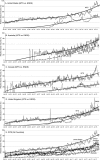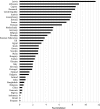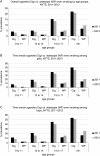The global epidemiology of waterpipe smoking
- PMID: 25298368
- PMCID: PMC4345835
- DOI: 10.1136/tobaccocontrol-2014-051903
The global epidemiology of waterpipe smoking
Abstract
Objectives: In the past decade, waterpipe smoking (a.k.a. hookah, shisha, narghile) has become a global phenomenon. In this review, we provide an updated picture of the main epidemiological trends in waterpipe smoking globally.
Data sources: Peer-reviewed publications indexed in major biomedical databases between 2004 and 2014. Search keywords included a combination of: waterpipe, hookah, shisha along with epidemiology, patterns, prevalence and predictors. We also used different spellings of waterpipe terms commonly used.
Study selection: The focus was on studies with large representative samples, national data or high-quality reports that illuminated aspects of the epidemiology and trends in waterpipe smoking.
Data extraction: Multiple researchers extracted the data independently and collectively decided on the most important and pertinent studies to include in the review.
Data synthesis: Waterpipe smoking has become a global phenomenon among youth. The global waterpipe epidemic is likely driven by (1) the introduction of manufactured flavoured tobacco (Maassel); (2) the intersection between waterpipe's social dimension and thriving café culture; (3) the evolution of mass communication media; (4) the lack of regulatory/policy framework specific to the waterpipe. Waterpipe smoking is becoming the most popular tobacco use method among youth in the Middle East, and is quickly gaining popularity elsewhere. Important patterns of waterpipe smoking include the predominance among younger, male, high socioeconomic, and urban groups. Intermittent and social use are also noted patterns.
Conclusions: Waterpipe smoking has become a global public health problem. Developing surveillance, intervention and regulatory/policy frameworks specific to the waterpipe has become a public health priority.
Keywords: Global health; Media; Nicotine; Non-cigarette tobacco products; Public policy.
Published by the BMJ Publishing Group Limited. For permission to use (where not already granted under a licence) please go to http://group.bmj.com/group/rights-licensing/permissions.
Figures









References
-
- Maziak W, Ward KD, Eissenberg T. Interventions for waterpipe smoking cessation. Cochrane Database Syst Rev 2007;(4):CD005549 (accessed as up-to-date: 8 Mar 2011). - PubMed
Publication types
MeSH terms
Substances
Grants and funding
LinkOut - more resources
Full Text Sources
Other Literature Sources
Miscellaneous
